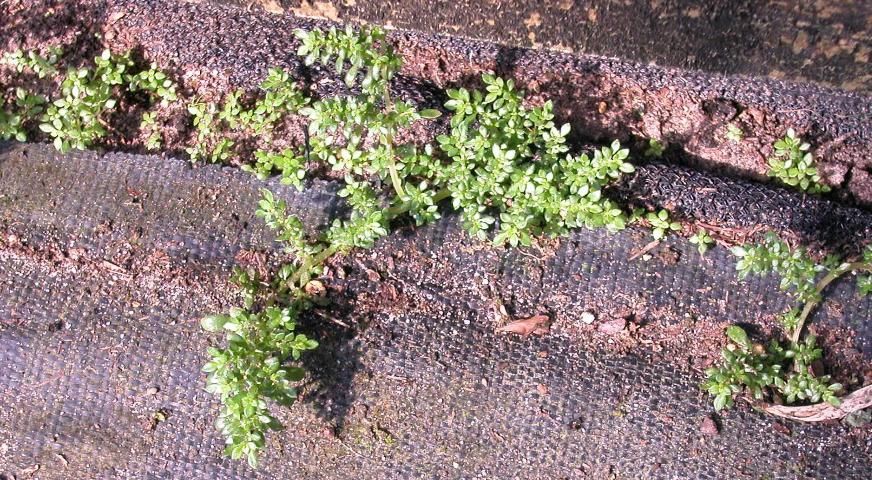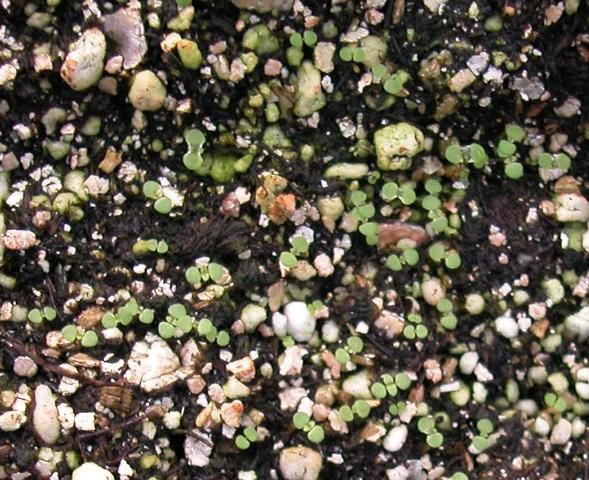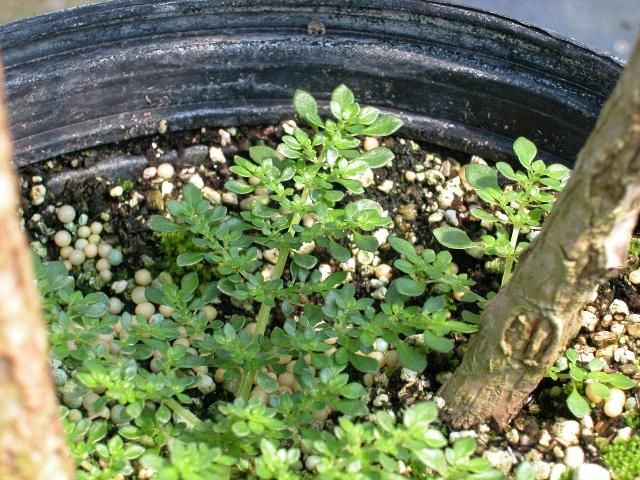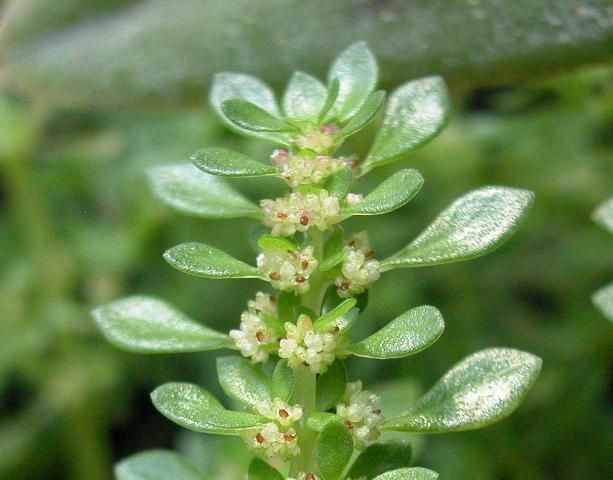Species Description
Class: Dicotyledonous plant
Family: Urticaceae
Other Common Names: rockweed, gunpowder plant, artillery fern
Life Span: annual or short-lived perennial
Habitat: Artillery weed occurs primarily in moist, disturbed areas but can tolerate dry conditions once established. In landscapes, artillery weed is typically found growing in rock mulch beds, in cracks in driveways and hardscapes, and in planting beds. In nurseries, it can be problematic in containers, container drain holes, ground cloth (Figure 1), walkways, aisles, and in greenhouses. It prefers a partially shaded environment but can grow in full sun.

Credit: Annette Chandler, UF/IFAS
Distribution: Artillery weed is thought to be native to South America, but some authors claim it is native to parts of North America (USDA 2016). It is found throughout Florida, but is most problematic in the central and southern parts of the state. It has also become widely naturalized in subtropical and tropical areas in many parts of the world.
Growth Habit: It is a low-growing succulent herb that can spread 1 to 2 feet in width and grows 0.5 to 1.5 feet in height.
Seedling: Cotyledons are green with opposite, obcordate (they start at a point and then widen until they form a notch at the apex) leaves with smooth margins (Figure 2). First true leaves are green. Stems are whitish in color.

Credit: Annette Chandler, UF/IFAS
Shoots: Stems are fragile, green, nearly translucent, succulent, and spreading (Figure 3). Plants have opposite to subopposite simple, obovate leaves with short petioles and with most but not all leaves having three primary veins originating from the leaf base. Leaves are evergreen and are 3.64–1.13 mm wide and 8.25–1.14 mm long.

Credit: Annette Chandler, UF/IFAS
Roots: Fibrous roots or rarely a short taproot.
Inflorescence: dense cyme (a group of flowers where the growing points end in a flower), branched clusters from leaf axils
Flowers: small, whitish to greenish, unisexual; sepals 4 mm in male flowers, 3 mm in female; no petals; 4 stamens; year round flowering occurs (Figure 4).

Credit: Annette Chandler, UF/IFAS
Fruits: achene, light brown, length less than 0.5 mm, smooth (Gilman 1999).
Similar Species: Pilea pumila (Canadian clearweed) is a similar species to Pilea microphylla. The distinguishing character of Pilea pumila is that it has broad, ovate to elliptic leaves, that grow to 4 in. long and 2.5 in. wide, and leaf margins are toothed (serrated). Artillery weed has small smooth-edged leaves, usually less than 8.25 mm long and 3.64 mm wide.
Plant Biology: Year-round flowering occurs, and the pollen grains are ejected forcefully (hence the common name artillery weed). Artillery weed grows primarily in shaded areas and can tolerate extended flooding, alkalinity, clay, sand, and acidic loam (Gilman 1999). This plant shows moderate drought tolerance and poor tolerance in soils with high salinity (Gilman 1999).
Management
Cultural and Physical Control
Cultural control involves proper sanitation practices, such as using weed-free growing media and clean pots. Inspect plant material for artillery weed seedlings when bringing in new plant material into the nursery or landscape. In landscapes, remove artillery weed seedlings from potted plants before transplanting to prevent future infestations.
Hand weeding effectively controls artillery weed in small areas. Because small seedlings are not easily removed by hand and artillery weed can regrow from roots or stem fragments, hand weeding must be thorough. Large and densely infested areas may be too labor intensive for such thorough hand weeding. Applying organic mulch (pinestraw, pinebark, etc.) at a depth of at least 2 inches has been shown to provide control in research trials.
Chemical Control
Preemergence Control
Most of the common preemergence herbicides provide excellent control of artillery weed. Oxyfluorfen has been shown to provide good control (Freitas et al. 2004, Freitas et al. 2007a, Freitas et al. 2007b). Research trials at UF/IFAS have shown the following preemergents to provide excellent control: oxadiazon (Ronstar® G), dimethanamid-p (Tower®), indaziflam (Marengo® or Specticle®), pendimethalin + dimethanamid-p (FreeHand®), oxyfluorfen + pendimethalin (OH2®), oxyfluorfen + prodiamine (Biathlon®), prodiamine (Barricade®), pendimethalin (Pendulum®), s-metolachlor (Pennant Magnum®), isoxaben (Gallery®), and prodiamine + isoxaben (Gemini™). Table 1 lists preemergence herbicides labeled for use in ornamental plant production and landscapes and that can be used for the control of artillery weed.
Postemergence Control
Tank-mixing a preemergence herbicide in with a postemergence herbicide can improve control of artillery weed, which is a prolific seed producer. Herbicides, including oxadiazon (Ronstar® FLO) (Conover and Stamps 1994), flumioxazin (SureGuard®), and glufosinate (Finale®), have provided excellent postemergence control in research trials. Oxadiazon and flumioxazin are both primarily used as preemergence herbicides but do provide some early postemergence control. In greenhouse trials, these two herbicides have provided greater than 95% control of mature artillery weed. Contact herbicides, including pelargonic acid (Scythe®) and diquat (Reward®), can provide temporary control, but re-treatment is typically needed. Glyphosate (RoundUp® and many others), sulfosulfuron (Certainty®), and sulfentrazone (Dismiss®) typically only provide suppression or poor control. If artillery weed is growing in large containers, directed applications can be made using a contact action herbicide such as pelargonic acid or diquat but care must be taken to ensure ornamental foliage is not contacted. If the ornamental growth habit does not allow for directed applications to be made, granular formulations of oxadiazon (Ronstar® G) and liquid formulations of dimethenamid-p (Tower®) can provide some suppression of small artillery weed and are labeled for over-the-top use in many crops. A list of postemergence herbicides, including their labeled sites, are included in Table 2.
References
Conover, C. A., and R.H. Stamps. 1994. Controlling artillery plant (Pilea microphylla) with herbicides. University of Florida Research Report RH-94-7. http://mrec.ifas.ufl.edu/foliage/resrpts/rh_94_7.htm
Freitas, F. C. L,. et al. 2004. "Chemical weed control in bromeliários." Congresso Brasileiro Da Ciência Das Plantas Daninhas São Pedro 24 CD-ROM.
Freitas, F. C. L., J.A.S Grossi, A.F. Barros, E.R. Mesquita, F.A. Ferreira, and J.G. Barbosa. 2007a. "Chemical control of Pilea microphylla in Orchid cultivation." Planta Daninha 25(3): 589–593.
Freitas, F. C. L., J.A.S Grpsso, A.F. Barros, E.R. Mesquita, and F.A. Ferreira. 2007b. "Weed control in ornamental plant seedling production." Planta Daninha 25(3) 595–601.
Gilman, E. F. 1999. Pilea microphylla Artillery Plant. FPS479. Gainesville: University of Florida Institute of Food and Agricultural Sciences. https://edis.ifas.ufl.edu/fp479
Mallory-Smith, Carol A. and E. James Retzinger, Jr. 2003. "Revised Classification of Herbicides by Site of Action for Weed Resistance Management Strategies." Weed Technology 17(3): 605–19. http://www.jstor.org/stable/3989198
USDA Plants Database. 2016. Pilea microphylla (L.) Liebm. http://plants.usda.gov/core/profile?symbol=PIMI2
Preemergence herbicides labeled for use in ornamental plant production and landscapes and their efficacy for control of artillery weed.